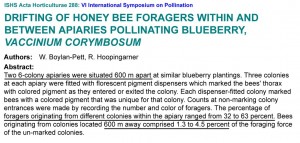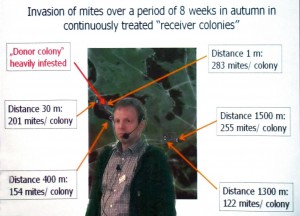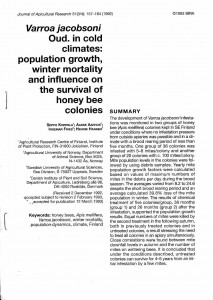Mites spread easily to other bee colonies. Sometimes though this seems not to be of great importance when designing tests or setting up areas for developing mite resistant bees. Sometimes one can wonder why ’control colonies’ in tests are placed in the same apiary as test colonies or even within 2 km. Especially if you let the mite population grow to see eventual differences.
Sometimes those who design tests say you don’t get the same environment conditions if you don’t place controls in the same apiary. Now that’s exactly what you don’t get when you place them in the same apiary, concerning what’s most important for what you are investigating. To nullify as much as possible that available plants and microclimate are somewhat different you use more apiaries and more colonies in the test. You need much data anyway to get reliable results.
Let’s look at some research on this topic.
1. Under certain circumstances when you move colonies, when you place them at the new place, the bees drift a lot. Look at this summary from ISHS Acta Horticulturae 288 (Jan 1991): http://www.actahort.org/books/288/288_12.htm
The same data you find in Phytopatology Vol 81, No 11, 1991, s 1407-1412: http://www.apsnet.org/publications/phytopathology/backissues/Documents/1991Articles/Phyto81n11_1407.pdf
2. In March 2011 John Kefuss, Peter Rosenkrantz and Ingemar Fries lectured in Hässleholm, Sweden on a conference about breeding varroa resistant bees. Rosenkrantz shared experiences from a test showing mites spreading from a heavily infested colony, a ‘donor’ colony. On 5 different distances a ’receiver’ colony was placed. From 1 meter up to 1.5 km. These receiver colonies were treated each week with an effective miticide and mites were counted in the downfall.
During these 8 weeks the donor colony gave 1015 mites to the 5 receiver colonies. Almost as many were received 1.5 km from the donor as 1 meter from it. No other colonies than these 6 were present close enough to interfere.
3. In 1992 Seppo Korpela, Aasne Aarhus, Ingemar Fries and Henrik Hansen published a test in Journal of Apicultural Research vol 31 (3/4): 157-164: Varroa Jacobsoni Oud. in cold climates: population growth, winter mortality and influence of the survival of honey bee colonies.
A part of the colonies in one of the two test apiaries were in autumn 1990 treated with an effective miticide, Bayvarol, while the rest were not treated. Next autumn when all were treated with Apistan, another effective miticide, there was no difference in the mite downfall between the two groups in the apiary. A quote: ”After treating five colonies of group 1 in autumn 1990, the mite populations in treated colonies equalized during late summer and autumn 1991 probably because of drifting and robbing as suggested by Sakofski et al (1990), Büchler and Hoffmann (1991) and Greatti et al (1992).”
4. In the doctorate thesis by Jasna Kralj 2004, ’Parasite–host interactions between Varroa destructor Anderson and Trueman and Apis mellifera L.: Influence of parasitism on flight behaviour and on the loss of infested foragers’ he shares interesting findings. For example: ’Ritter and Leclercq (1987) found that low infested colonies built up mite populations relatively fast when surrounded by infested colonies in the radius of 2 km.’ http://www.dlib.si/stream/URN:NBN:SI:doc-RVC09019/ca3b2691-15f0-4e32-864e-63c285503dfb/PDF
Kraljs tests showed that about half of the bees with mites on them that flew out of the colonies didn’t return. The conclusion made with the help of tests of Kralj is that they entered other hives. Some of the infested bees that did return had lost their mites.
So when you are testing different stocks of bees or management aspects like for example small cells, or developing resistant bees, you have to take in consideration the above facts.




Erik, thanks for discussing that interesting topic…
I guess most of the people that deal with varroa resistant bees, are not in the situation to say my bees withstand every varroa load and will definitely not collaps in terms of varroa. Hence, varroa intake is an important factor that decides whether a colony survives or not.
For every treatment free beekeeper in Europe it was essential in former times to look for remote areas, which control the varroa intake only for the own hives. However, varroa resistance of bees have improved since that time and colonies are able to cope with varroa better and better. Since a while this can be quantified by useful assays like VSH test (see recent blog on this topic) and VSH level of up to 100% are meanwhile possible.
However, to my knowledge relatively less is known about how that number (VSH index) correlates to varroa load. Or in other words: how many varroa mites can be accepted by a colony with lets say 75% VSH? This might be defined as varroa clearance per time as well.
At the moment some empirical numbers are known e.g. 7 hives with high VSH can tolerate 3 hives with low or no VSH. However, vice versa (7 low and 3 high) it doesn’t work. Similary, Adam Finkelstein, a VSH breeder from the US, reports that in his apiary he has some wanted colonies that collapse due to varroa overkill. And this is wanted as this works as selection tool for the other resistant hives and proof their abilities.
Taken together, situation in regard to varroa load has improved meanwhile, but solid numbers of the tolerated varroa load are missing (at least to my knowledge).
How varroa can approach own hives has been described in the above blog and it seems clear that intake rates are pretty high even about significant distances (up to 2km and maybe more).
What kind of strategies can be used to overcome or at least limit this varroa intake, when neighbouring?
Certainly look for a remote area… However, especially in some higher populated area this becomes difficult.
Secondly, you can select for bees that control the hive entrance superior (e.g. Primorski bees or others). Although mites can transfer during the scrap at the entrance to the guard bees varroa load should be lower in these colonies.
Thirdly, maybe VSG or grooming might prevent mites from going into the reproductive phase (although this trait belongs strictly speaken to the resistance traits at all).
Fourthly, building communities, which rely on treatment free bee keeping principles and occupy certain areas in which resistant bee hives are condensed.
Fivthly, continuous breeding efforts and spread of relevant resistance genes in your neighborhood.
Here’s another interesting report on sharing of mites. Here it seems it is more to take in consideration, small cell bees and large cell bees. http://www.resistantbees.com/reinf_e.html